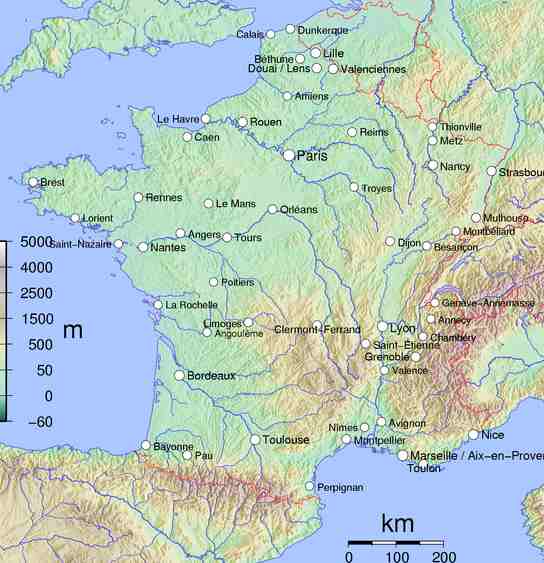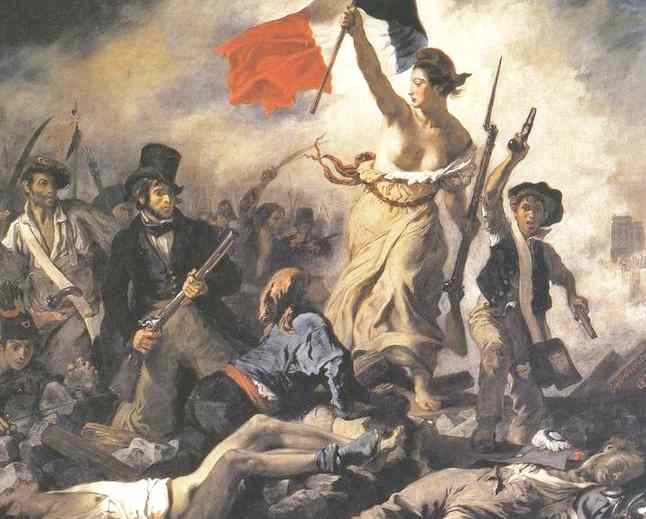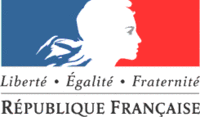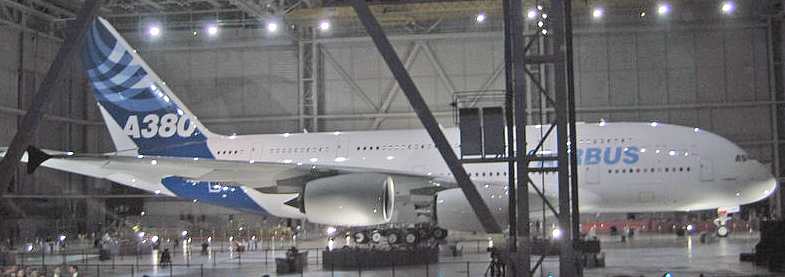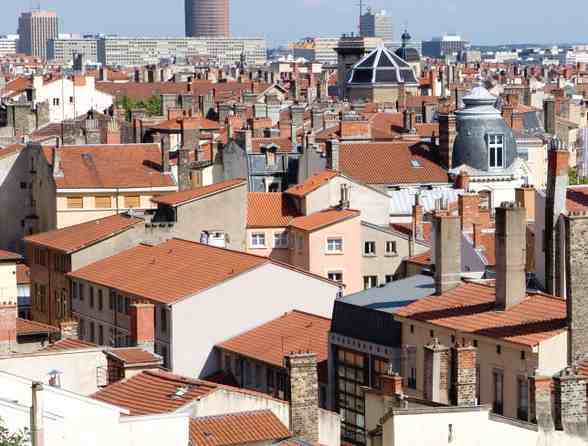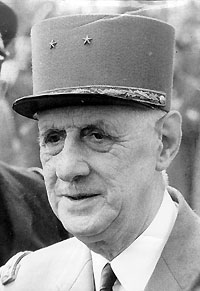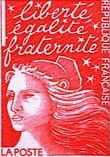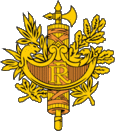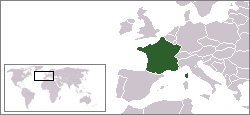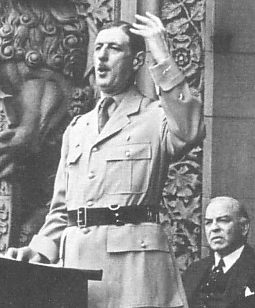|
FRANCE
|
|||||||||||||||||||||||||||||||||||||||||||||||||||||||||||||||||||||||||||||||||||||||||||||||||||||||||
|
France is known officially as the French Republic (French: République française, a country whose metropolitan territory is located in Western Europe and that is further made up of a collection of overseas islands and territories located in other continents. Metropolitan France extends from the Mediterranean Sea to the English Channel and North Sea, and from the Rhine River to the Atlantic Ocean. French people often refer to Metropolitan France as l'Hexagone (the "Hexagon") because of its geographical shape.
France is bordered by Belgium, Luxembourg, Germany, Switzerland, Italy, Monaco, Andorra, and Spain. In some of its overseas parts, France also shares land borders with Brazil, Suriname, and the Netherlands Antilles. France is also linked to the United Kingdom via the Channel Tunnel, which passes underneath the English Channel.
Map of France
The French Republic is a democracy which is organized as a unitary semi-presidential republic. It is a highly developed country with the sixth-largest economy in the world. Its main ideals are expressed in the Declaration of the Rights of Man and of the Citizen. France is one of the founding members of the European Union, and has the largest land area of all members. France is also a founding member of the United Nations, and a member of the francophonie, the G8, and the Latin Union. It is one of the five permanent members of the United Nations Security Council wielding veto power, and it is also one of only eight acknowledged nuclear powers. With almost 75 million foreign tourists each year, France is also a popular tourist destination around the world.
The name France originates from the Franks, a Germanic tribe that occupied the region after the fall of the Western Roman Empire. More precisely, the region around Paris, called Île-de-France, was the original French royal demesne.
Geography
While the main territory of France (metropolitan France; French: la Métropole, France métropolitaine or informally l'hexagone) is located in Western Europe, France is also constituted from a number of territories in North America, the Caribbean, South America, the southern Indian Ocean, the Pacific Ocean, and Antarctica (sovereignty claims in Antarctica are governed by the Antarctic Treaty System). These territories have varying forms of government ranging from overseas département to "overseas country".
Metropolitan France possesses a wide variety of cites from coastal plains in the north and west to mountain ranges in the south-east (the Alps) and the south-west (the Pyrenees). The French rivers contain the highest point in western Europe, Mont Blanc at 4,810 metres (15,781 ft). There are several other elevated regions such as the Massif Central, the Jura, the Vosges, and the Ardennes which are quite rocky and forested. France also has extensive river systems such as the Loire, the Rhône, the Garonne and the Seine.
Due to its overseas departments and territories scattered on all oceans of the planet, France possesses the second-largest Exclusive Economic Zone (EEZ) in the world, covering 11,035,000 km² (4,260,000 mi²), just behind the EEZ of the United States (11,351,000 km² / 4,383,000 mi²), but ahead of the EEZ of Australia (8,232,000 km² / 3,178,000 mi²). The EEZ of France covers approximately 8% of the total surface of all the EEZs of the world, whereas the land area of the French Republic is only %2 of the total land area on Earth.
History
The borders of modern France are roughly the same as those of ancient Gaul, which was inhabited by Celtic Gauls. Gaul was conquered by Julius Caesar in the 1st century BC, and the Gauls eventually adopted Roman speech (Latin, which evolved into the French language) and Roman culture. Christianity took root in the 2nd century and 3rd century AD, and became so firmly established by the fourth and fifth centuries that St. Jerome wrote that Gaul was the only region free from heresy. In the Middle Ages, the French would adopt this as a justification for calling themselves "the Most-Christian Kingdom of France".
In the 4th century AD, Gaul's eastern frontier along the Rhine was overrun by Germanic tribes, principally the Franks, from whom the ancient name of "Francie" was derived. The modern name "France" derives from the name of the feudal domain of the Capetian Kings of France around Paris. Existence as a separate entity began with the Treaty of Verdun (843), with the division of Charlemagne's Carolingian empire into East Francia, Middle Francia and Western Francia. Western Francia approximated the area occupied by modern France.
Eugène Delacroix - La liberté guidant le peuple, Liberty leading the People, a symbol of the French Revolution of 1830
The Carolingians ruled France until 987, when Hugh Capet, Duke of France and Count of Paris, was crowned King of France. His descendants, the Capetian, Valois and Bourbon dynasties progressively unified the country through a series of wars and dynastic inheritance. The monarchy reached its height during the 17th century and the reign of Louis XIV. At this time France had a tremendous influence over European politics, economy and culture and possessed the largest population in Europe.
The monarchy ruled France until 1792, when the French Revolution took place. King Louis XVI and wife, Marie Antoinette, were killed, along with thousands of other French citizens. Napoleon Bonaparte seized control of the Republic in 1799, making himself First Consul, and later Emperor of what is now known as the First French Empire (1804-1814). In the course of several wars, his armies conquered many countries, with members of the Bonaparte family being appointed as monarchs of newly established kingdoms.
Following Napoleon's defeat in 1815, the French monarchy was re-established. In 1830, a civil uprising established the constitutional July Monarchy followed by the Second Republic in 1848. The short-lived Second Republic ended in 1852 when Louis-Napoléon Bonaparte proclaimed the Second French Empire. Louis-Napoléon was unseated following the Franco-Prussian war of 1870 to be replaced by the Third Republic.
France had colonial possessions, in various forms, since the beginning of the 17th century until the 1960s. In the 19th and 20th centuries, its global colonial empire was the second largest in the world behind the British Empire. At its peak, between 1919 and 1939, the second French colonial empire extended over 12,347,000 km² (4,767,000 sq. miles) of land. Including metropolitan France, the total area of land under French sovereignty reached 12,898,000 km² (4,980,000 sq. miles) in the 1920s and 1930s, which is 8.6% of the world's land area.
France's ultimate victory in World War I and World War II after initially being invaded and partly occupied by German forces did not prevent the loss of the colonial empire, the comparative economic status, population and status as a dominant nation state. The Fourth Republic was established after World War II, to be replaced in 1958 by the current semi-presidential Fifth Republic established under General Charles de Gaulle.
Almost immediately after World War II, France had to engage in suppressing a bitter independence struggle in Indochina. When this ended with French defeat and withdrawal in 1=954, the French almost immediately became involved in a new, and even harsher conflict in their oldest major colony, Algeria. Charles de Gaulle's accession to power in 1958 ultimately led to independence for Algeria in 1962 after the Algerian War of Independence.
In recent decades, France's reconciliation and cooperation with Germany have proved central to the political and economic integration of the evolving European Union, including the introduction of the euro in January 1999. France has been at the forefront of European Union member states seeking to exploit the momentum of monetary union to create a more unified and capable European Union based political, defence and security apparatus. However the French electorate voted against ratification of the European Constitutional Treaty in May 2005.
Symbol of the French government
Government and politics
The constitution of the Fifth Republic was approved by referendum on September 28, 1958. It greatly strengthened the authority of the executive in relation to Parliament.
Under the constitution, the President of the French Republic is elected directly by universal adult suffrage for a 5-year (originally 7-year) term. Presidential arbitration assures regular functioning of the public powers and the continuity of the state. The president names the prime minister, presides over the cabinet, commands the armed forces, and concludes treaties.
The French parliament is a bicameral legislature comprising a National Assembly (Assemblée Nationale) and a Senate. The National Assembly deputies represent local constituencies and are directly elected for 5-year terms. The Assembly has the power to dismiss the cabinet, and thus the majority in the Assembly determines the choice of government. Senators are chosen by electoral college for 6-year terms (originally 9-year terms), and one half of the seats are submitted to election every 3 years starting in September 2008.
The Senate's legislative powers are limited; in the event of disagreement between the two chambers, the National Assembly has the final say, except for constitutional laws (amendments to the constitution & "lois organiques"). The government has a strong influence in shaping the agenda of Parliament.
For the past thirty years, French politics has been characterised by the two politically opposed groupings: one left-wing, centred around the French Socialist Party, and the other right-wing, centred around the Rassemblement pour la République (RPR) and its successor the Union pour un Mouvement Populaire (UMP). The right-wing Front National party made significant inroads in the early 1980's, seized on voter concern about the perceived decline of France and 'national dissolution' as a result of immigration and globalisation, by advocating tougher law-and-order and immigration policies. Lately its share of the votes has remained stable at approximately 16%.
French foreign policy has been largely shaped by membership of the European Union. On May 29, 2005 the French electorate voted in the referendum with about 55% against ratification of the proposed Treaty establishing a Constitution for Europe. The outcome of the vote was widely regarded as crucial for the future development of the EU, as well as for France's ability to retain leadership in Europe.
France is also a member of the Secretariat of the Pacific Community (SPC), the Indian Ocean Commission (COI), an associate member of the Association of Caribbean States (ACS) and a leading member of the International Francophone Organisation (OIF) of fifty-one fully or partly French-speaking countries.
France hosts the headquarters of the OECD, UNESCO, Interpol, and the International Bureau for Weights and Measures in charge of the international metric system.
Administrative divisions
France is divided into 26 administrative régions: 22 are in metropolitan France (21 are on the continental part of metropolitan France; one is the "territorial collectivity" of Corse, on the island of Corsica, commonly referred to as a région in common speech), and four are overseas régions. The régions are further subdivided into 100 départements. The departments are numbered (mainly alphabetically) and this number is used, for instance, in postal codes and vehicle number plates.
The departments are further subdivided into 342 arrondissements, but they have no elected assembly and serve only for the districting of state administrations. The arrondissements are further divided into 4,035 cantons, but again these serve only administrative and electoral purposes. Finally, the arrondissements are divided into 36,682 communes, which are municipalities with an elected assembly (municipal council).
The régions, départements, and communes are known as "territorial collectivities" (collectivités territoriales), meaning they possess local assemblies as well as an executive, while the arrondissements and the cantons are mere administrative divisions. Until 1940, the arrondissements were also territorial collectivities with an elected assembly (arrondissement council), but these were suspended by the Vichy regime and definitely abolished by the Fourth Republic in 1946. Historically, the cantons were also territorial collectivities with their elected assemblies.
1st Airbus A380 at the "A380 Reveal" event in Toulouse on January 18 2005
Four of the départements are overseas départements (coterminous with the four overseas régions) which are an integral part of France (and the EU) and thus enjoy a status similar to metropolitan départments.
In addition to the 26 régions and 100 départements, the French Republic is further made up of four overseas collectivities, one sui generis collectivity (New Caledonia), and one overseas territory.
Overseas collectivities and territories form part of the French Republic, but do not form part of the EU or its fiscal area. The Pacific territories continue to use the Pacific Franc whose value is linked to that of the Euro. In contrast, the four overseas régions/départements used the French franc and now use the euro.
France also maintains control over a number of small non-permanently inhabited islands in the Indian Ocean and the Pacific Ocean: Bassas da India, Clipperton Island, Europa Island, Glorioso Islands, Juan de Nova Island, Tromelin Island. See Islands controlled by France in the Indian and Pacific oceans.
Transportation
Military
The French armed forces are divided into four branches:
Military age is 17. Since the Algerian War of Independence, conscription has been steadily reduced and was abolished by the government of Jacques Chirac in 1996.
Among the larger European economies, France and the United Kingdom are the only significant spenders on defence: France with 2.6% of GDP, and the UK at 2.4%, according to 2003 figures from NATO. Those two countries account for 40% of EU defence spending. In most other EU countries, defence spending is less than 1.5% of GDP. About 10% of France's defence budget goes toward its force de frappe, or nuclear weapons.
Economy
France's economy combines extensive private enterprise (nearly 2.5 million companies registered) with substantial (though declining) government intervention (see dirigisme). The government retains considerable influence over key segments of infrastructure sectors, with majority ownership of railway, electricity, aircraft, and telecommunication firms. It has been gradually relaxing its control over these sectors since the early 1990s. The government is slowly selling off holdings in France Télécom, Air France, as well as the insurance, banking, and defense industries.
A member of the G8 group of leading industrialized countries, it ranked as the fifth-largest economy in the world in 2004, behind the United States, Japan, Germany, and the United Kingdom. France joined 10 other EU members to launch the Euro on January 1, 1999, with euro coins and banknotes completely replacing the French franc in early 2002.
According to the OECD, in 2004 France was the world's fifth-largest exporter of manufactured goods, behind the United States, Germany, Japan, and China, (but ahead of the United Kingdom). It was also the fourth-largest importer of manufactured goods (behind the United States, Germany, and China, but ahead of the United Kingdom and Japan).
Yet according to the OECD, in 2003 France was the OECD country that received the most foreign direct investment (with the exception of Luxembourg, where foreign direct investment was mostly monetary transfers to banks located in that country). With 47 billion USD of foreign direct investments, France ranked above the United States (39.9 billion USD of FDI received), the United Kingdom (14.6 billion USD of FDI received), Germany (12.9 billion USD of FDI received), or Japan (6.3 billion USD of FDI received).
At the same time, French companies invested 57.3 billion USD outside of France, ranking France as the second most important outward direct investor in the OECD, behind the United States (173.8 billion USD of outward FDI), but ahead of the United Kingdom (55.3 billion USD of outward FDI), Japan (28.8 billion USD of outward FDI), or Germany (2.6 billion USD of outward FDI).
In the 2005 edition of OECD in Figures, the OECD also noted that France leads the G8 countries in terms of productivity (measured as GDP per hour worked). In 2004, the GDP per hour worked in France was 47.7 USD, ranking France above the United States (46.3 USD per hour worked), Germany (42.1 USD per hour worked), the United Kingdom (39.6 USD per hour worked), or Japan (32.5 USD per hour worked).
Despite figures showing a higher productivity per hour worked than in the US, France's GDP per capita is significantly lower than the US GDP per capita, being in fact comparable to the GDP per capita of the other European countries, which is on average 30% below US level. The reason for this is because a much smaller percentage of the French population is working compared to the US, which sinks the GDP per capita of France, despite its higher productivity. In fact, France has one of the lowest percentages of its population at work among the OECD countries. In 2003, 41.5% of the French population was working, compared to 50.7% in the US, and 47.3% in the UK. This phenomenon is the result of almost thirty years of massive unemployment in France, which has led to three consequences reducing the size of the working population: about 10% of the active population is without a job; students delay as long as possible their entry into labour market; and finally the French government gives various incentives to workers to retire in their early 50s, though these are now receding.
As many economists have stressed repeatedly over the years, the main issue with the French economy is not an issue of productivity. In their opinion, it is an issue of structural reforms, in order to increase the size of the working population in the overall population. Liberal and Keynesian economists have different answers to that issue. Lower working hours and the reluctance to reform the labour market are mentioned as weak spots of the French economy.
With over 75 million foreign tourists in 2003, France is ranked as the first tourist destination in the world, ahead of Spain (52.5 million) and the United States (40.4 million). It features cities of high cultural interest (Paris being the foremost), beaches and seaside resorts, ski resorts, and rural regions that many enjoy for their beauty and tranquillity (green tourism).
France has an important aerospace industry led by the European consortium Airbus and is the only European power (excluding Russia) to have its own national spaceport (Centre Spatial Guyanais). France is also the most energy independent Western country due to heavy investment in nuclear power, which also makes France the smallest producer of carbon dioxide among the seven most industrialized countries in the world. Large tracts of fertile land, the application of modern technology, and EU subsidies have combined to make France the leading agricultural producer in Europe.
Since the end of the Second World War the government made efforts to integrate more and more with Germany, both economically and politically. Today the two countries form what is often referred to as the "core" countries in favour of greater integration of the European Union.
View over the old city of Lyon
Demographics
Since prehistoric times, France has been a crossroads of trade, migrations, and invasions. Four basic European ethnic stocks - pre-Celtic, Celtic (Gallic and Breton), Latin, and Germanic (Franks, Visigoths, Burgundians, Vikings) - have blended over the centuries to make up its present population. Besides these "historic" populations, new populations have migrated to France since the 19th century: Belgians, Italians, Spaniards, Portuguese, Poles, Romanians, Armenians, Jews from Eastern Europe and the Maghreb, Arabs and Berbers from the Maghreb, Black Africans, and Chinese people, to list only the most prominent. It is currently estimated that about 40% of the French population descends in varying amounts from these different waves of migrations, making France the most ethnically diverse country of Europe, despite the still popular stereotypes of France as an essentially Gallic country. Nevertheless, the immigrants from other European countries have an easier time blending in, while the non-European groups tend to assimilate at a slower pace, because of greater cultural barriers and social discrimination.
Population
Starting with the 19th century, the historical evolution of the population in France has been extremely atypical in the Western World. Unlike the rest of Europe, France did not experience a strong population growth in the 19th century and first half of the 20th century. On the other hand, it experienced a much stronger growth in the second half of the 20th century than the rest of Europe or indeed its own growth in the previous centuries.
After 1974, France's population growth stalled, and reached its nadir in the 1990s with only 0.39% annual growth, being now more in tune with the rest of Europe, which has entered demographic decline. However, first results from the 2004 French census have greatly surprised demographers. The census revealed that population growth rebounded significantly after the 1999 census, something nobody had anticipated. From 1999 to 2003, annual population growth was 0.58%. In 2004, population growth was 0.68%, almost reaching North American levels. 2004 was the year with the highest increase in French population since 1974. France is now well ahead of all other European countries (except for the Republic of Ireland). In 2003, France's natural population growth (excluding immigration) was responsible for almost all the natural growth in European population: the population of the European Union increased by 216,000 inhabitants (without immigration), of which 211,000 was the increase in France's population alone, and 5,000 was the increase in all the other countries of the EU combined. In 2004 the natural increase in France's population reached 256,000, but figures for other European countries are not available yet.
These unexpected results bear great consequences for the future. At the moment, France is the third most populous country of Europe, behind Russia and Germany. By 2050, demographers initially thought the population of metropolitan France would be 64 million inhabitants, but they now agree that their estimates were too conservative, being based on the 1990s growth rate of population. Demographers now estimate that by 2050 metropolitan France's population will be 75 million, at which time it will be the most populated country of the European Union, above Germany (71 million), the United Kingdom (59 million), and Italy (43 million).
In 2005, birth and fertility rates continued to increase. The natural increase of births over deaths rose to 270,100. The lifetime fertility rate rose to 1.94 in 2005, from 1.92 in 2004. Net immigration fell slightly in 2005 to 97,500. In France immigration accounts for about on quarter of the total population increase--the average for all of Europe is about 80%.
Source: http://www.insee.fr/en/ffc/docs_ffc/IP1059en.pdf
If these estimates become reality, it may fundamentally alter the balance of power in Brussels. It would be the first time since the 1860s that France is the nation with the largest population within Europe (Russia excluded). In mid-2004 the EU had 460 million inhabitants, 13.6% of whom were living in France (including overseas départements). By 2050 it is estimated that the population of the European Union (of the current 25 members) will have declined to 445 million inhabitants, of whom 17.5% will be living in France.
According to the UNHCR, the number of people seeking political asylum in France rose by around 3 % between 2003 and 2004, while in the same period, the number of asylum applications submitted in the United States fell by about 29 %. France thereby replaced the United States as the world's top destination for asylum-seekers in 2004.
A perennial political issue concerns rural depopulation. Over the period 1960-1999 fifteen rural départements experienced a decline in population. In the most extreme case, the population of Creuse fell by 24%.
General De Gaulle
Languages
The sole official language of France is French, according to Article 2 of the Constitution since 1992. However, several regional languages (including Alsatian, Basque, Breton, Catalan, Corsican, Dutch, Franco-Provençal dialects, Gascon, Lorraine German dialect, Norman, Occitan, and some Oïl dialects - e.g., Picard) are also occasionally understood and spoken, mostly by elderly people. Also several creole languages are spoken in overseas departments. However, the French government and state school system discouraged the use of any of those languages until recently. These historical regional languages have been known as patois, though this has been considered depreciative. They are now taught at some schools, though French remains the only official language in use by the government, local or national.
Some languages spoken by immigrants are also frequently spoken, especially in large cities: Portuguese, Maghreb Arabic, several Berber languages, several languages of Sub-Saharan Africa, Turkish, several spoken variants of Chinese (most notably Wu, Cantonese, Min Nan, and Mandarin), Vietnamese, and Khmer are the most frequently spoken.
Despite popular stereotypes, many French can speak at least one foreign languages, mostly English, German, and Italian.
Statistics
At the 1999 census, INSEE sampled 380,000 adult people all across Metropolitan France, and asked them questions about their family situation. One of the questions was about the languages that their parents spoke with them before the age of 5. This is the first time serious statistics were computed about the proportion of mother tongues in France. The results were published in Enquête familiale, Insee, 1999.
Here is a list of the nine most prominent mother tongues in France based on Enquête familiale. It is important to read the notes at the Languages of France article in order to correctly interpret the numbers.
If we add up people with mother tongue and people with some exposure to the language before the age of 5, then the five most important languages in metropolitan France are (note that the percentages add up to more than 100, because many people are now counted twice):
Culture
French postage stamp depicting Marianne
Marianne
Marianne is a symbol of the French Republic. She is an allegorical figure of liberty and the Republic and first appeared at the time of the French Revolution. The earliest representations of Marianne are of a woman wearing a Phrygian cap. The origins of the name Marianne are unknown, but Marie-Anne was a very common first name in the 18th century. Anti-revolutionaries of the time derisively called her La Gueuse (the Commoner).
It is believed that revolutionaries from the South of France adopted the Phrygian cap as it symbolised liberty, having been worn by freed slaves in both Greece and Rome. Mediterranean seamen and convicts manning the galleys also wore a similar type of cap.
Under the Third Republic, statues, and especially busts, of Marianne began to proliferate, particularly in town halls. She was represented in several different manners, depending on whether the aim was to emphasize her revolutionary nature or her "wisdom." Over time, the Phrygian cap was felt to be too seditious, and was replaced by a diadem or a crown. In recent times, famous French actresses are given the title of Marianne. Recent ones are Sophie Marceau, and Laetitia Casta. She also features on everyday articles such as postage stamps and coins.
Religion
Traditionally a predominantly Roman Catholic country, yet also with anticlerical leanings, France has since the 1970s been a very secular country. Freedom of religion is constitutionally a right, inspired by the Declaration of the Rights of Man and of the Citizen. The dominant concept of the relationships between the public sphere and religions is that of laïcité, which implies that the government and government institutions (such as schools) should not endorse any particular religion or intervene in religious dogma, and that religions should refrain from intervening in policy-making. Tensions occasionally erupt about alleged or real discrimination against minorities; see Islam in France.
The government does not maintain statistics as to the religion of its inhabitants. Statistics from an unspecified source and date given in the CIA World Factbook gives the following number: Roman Catholic 83 to 88%, Muslim 5 to 10%, Protestant 2%, Jewish 1%. However, in a 2003 poll 41% said that the existence of God was "excluded" or "unlikely". 33% declared that "atheist" described them rather or very well, and 51% said they were "Christian". When questioned about their religion, 62% answered Roman Catholic, 6% Muslim, 2% Protestant, 1% Jewish, 2% "other religions" (except for Orthodox or Buddhist, which were negligible), 26% "no religion" and 1% declined to answer. A Gallup poll established that 15% of the French population attend places of worship.
In a more recent Eurostat "Eurobarometer" poll, in 2005, 34% of French citizens responded that "they believe there is a God", whereas 27% answered that "they believe there is some sort of spirit or life force" and 33% that "they do not believe there is any sort of spirit, God, or life force".
Terminology
Origin of the country's name
The name France comes from Medieval Latin Francia, which literally means "land of the Franks, Frankland". Originally it applied to the whole Frankish Empire, extending from southern France to eastern Germany. At the Treaty of Verdun in 843, the Frankish Empire was divided in three parts, and eventually only two: Francia Occidentalis (i.e. "Western Frankland") and Francia Orientalis (i.e. "Eastern Frankland"). The rulers of Francia Orientalis, who soon claimed the imperial title and wanted to reunify the Frankish Empire, dropped the name Francia Orientalis and called their realm the Holy Roman Empire (see History of Germany). The kings of Francia Occidentalis successfully opposed this claim, and managed to preserve Francia Occidentalis as an independent kingdom, distinct from the Holy Roman Empire. The Battle of Bouvines in 1214 definitely marked the end of the efforts by the Holy Roman Empire to reunify the old Frankish Empire by conquering France.
Since the name Francia Orientalis had disappeared, there arose the habit to refer to Francia Occidentalis as Francia only, from which the word France is derived. The French state has been in continuous existence since 843 (except for a brief interruption in 885-887), with an unbroken line of heads of states since the first king of Francia Occidentalis (Charles the Bald) to the current president of the French Republic (Jacques Chirac). Noticeably, Realm (or land) of the Franks is still quite a common way to denote France in many languages of today. Among those are Frankrig (Danish), Frankreich (German), Frakkland (Icelandic) and Frankrike (Norwegian/Swedish). In German, Frankreich (France) is also distinguished from Frankenreich, which means the Frankish Empire of Charlemagne.
The name of the Franks itself is said to come from the Proto-Germanic word *frankon which means "javelin, lance". Another proposed etymology is that Frank means "the free men", based on the fact that the word frank meant "free" in the ancient Germanic languages. However, rather than the ethnic name of the Franks coming from the word frank ("free"), it is more probable that the word frank ("free") comes from the ethnic name of the Franks, the connection being that only the Franks, as the conquering class, had the status of freemen.
The generally accepted etymology for the name of the former French currency, the franc, is that it is derived from the inscription Francorum Rex ("King of the Franks") on gold coins first made during the reign of John II of France ("Jean the Good", 1350-64). According to another, popular but less well established, theory the name of the currency comes from Old French franc, a word which meant "free", directly borrowed from the Germanic word frank ("free"). In modern French, franc means "frank, sincere". The meaning "free" was lost, except in a few set phrases, such as port franc (i.e. "free port") or franc-maçon (i.e. "freemason"). During the Hundred Years' War, John II was captured by the English at the Battle of Poitiers (1356). The English asked for a ransom to liberate the king, which amounted to twice the yearly income of France. In order to raise the money to pay the ransom, a new coinage had to be minted. These new coins were called francs, because they were minted to "free" the king.
Before the arrival of the Franks, the general area of France was called Gaul (Latin: Gallia; French: Gaule). This name continued to be used for a very long time after the Franks arrived in what is now France. In fact, for as long as the cultural elites of Europe used Latin predominantly (until the 18th century), the name Gallia continued to be used alongside the name France. Today, in modern French, the word Gaule has completely disappeared, and is only used in a historical context. The only current use of the word is in the title of the leader of the French bishops, the archbishop of Lyon, whose official title is Primate of the Gauls (Primat des Gaules). Gaul is in the plural in the title, reflecting the three Gallic entities identified by the Romans (Celtica, Belgica, and Aquitania). The adjective gaulois (Gallic) is still sometimes used when a Frenchman wants to stress some idiosyncrasies of the French people entrenched in history, such as notre vieux fond gaulois querelleur ("the love of quarrels of our old Gallic stock"), a phrase used when denouncing French propensity for strikes or controversies. During the French Third Republic, the authorities often referred to notre vieille Nation gauloise ("our old Gallic Nation"), a case in which the adjective gaulois is used with a positive connotation. The adjective gaulois is also used to describe a kind of humour located below the belt. In English the word Gaul is never used in a modern context. The adjective Gallic is sometimes used to refer to French people, especially in a derisive and critical way, such as "Gallic pride" or "Gallic hygiene".
Note that the family name of Charles de Gaulle (with two "l") has nothing to do with the name Gaul (French: Gaule, with one "l"). It seems that "Gaulle" comes from an old Germanic word meaning "wall", where w- evolved into g- under the influence of French (this shift has occurred in a number of words, cf. e. William/fr. Guillaume, e. waffle/fr. gaufre). Nonetheless, contemporary Frenchmen could not help noticing the striking similarity between the two names, and it added to the aura surrounding de Gaulle.
In almost all the languages of the world, France is known by the word "France" or any of its derivatives. In a few languages (essentially Greek and Breton), France is known as "Gaul".
Meanings of the name France
Charles Andre Joseph Marie de Gaulle
The name "France" (and its adjective "French") can have four different meanings which it is important to distinguish in order to avoid ambiguities. In a first meaning, "France" refers to the whole French Republic. In a second meaning, it refers to metropolitan France only. This is the most common meaning.
In a third meaning, "France" refers specifically to the province of Île-de-France (with Paris at its centre) which historically was the heart of the royal demesne. This meaning is found in some geographic names, such as French Brie (Brie française) and French Vexin (Vexin français). French Brie, the area where the famous Brie cheese is produced, is the part of Brie that was annexed to the royal demesne, as opposed to Champagne Brie (Brie champenoise) which was annexed by Champagne. Likewise, French Vexin was the part of Vexin inside Île-de-France, as opposed to Normandy Vexin (Vexin normand) which was inside Normandy.
This meaning is also found in the name of the French language (langue française), whose literal meaning is "language of Île-de-France". It is not until the 19th and 20th centuries that the language of Île-de-France indeed became the language of the whole country France. In modern French, the French language is called le français, while the old language of Île-de-France is called le francien.
In a fourth meaning, "France" refers only to the Pays de France, one of the many pays (Latin: pagi, singular pagus) of Île-de-France. French provinces are traditionally made up of several pays, which are the direct continuation of the pagi set up by the Roman administration during Antiquity. The province of Île-de-France is thus made up of several pays: Pays de France, Parisis, Hurepoix, French Vexin, and so on. Pays de France is the extremely fertile plain located immediately north of Paris which supported one of the most productive agriculture during the Middle Ages and was responsible for the tremendous wealth of the kingdom of France before the Hundred Years' War, making possible the emergence of Gothic art and architecture which spread all over western Europe. Pays de France is also called Plaine de France (i.e. "Plain of France"). Its historic main town is Saint-Denis, where the first gothic cathedral in the world was built in the 12th century, and inside which the kings of France are buried. Pays de France is now almost entirely built up, being but the northern extension of the Paris suburbs.
This fourth meaning is found in many place names, such as the town of Roissy-en-France, on whose territory is located Charles de Gaulle International Airport. The name of the town literally means "Roissy in the Pays de France", and not "Roissy in the country France", as many people wrongly believe. Another example of the use of France in this meaning is the new Stade de France, which was built near Saint-Denis for the 1998 Football World Cup. It was decided to call the stadium after the Pays de France, to give it a local touch. In particular, the mayor of Saint-Denis made it very clear that he wanted the new stadium to be a stadium of the northern suburbs of Paris, and not just a national stadium which happens to be located in the northern suburbs. The name reflected this. However, most people, both inside and outside France, are not aware of this, and assume that the stadium was called after the country France.
LINKS
Directories
Tourism, history, gastronomy
Maps and travel guides
DOOMSDAY OPERATION GRAND SLAM - Disillusioned extremists in Iran, North Korea and Russia, have grown impatient waiting for their leaders to act decisively, having watched the Ukraine debacle of Vladimir Putin rebound to weaken their CRINK axis members. This despite Hamas launching against Israel and Houthi attacks on the Red Sea. All that had the effect of waking the sleeping giant: NATO.
They
hatch a plot to kidnap top politicians from the west to create confusion,
as a prelude to an all out cyber
nuclear first and second strike, having first stockpiled sufficient gold
and weapons reserves, and fallout bunkers for their cells, to be able to
stage a second wave of conventional attacks, to in effect, take over the
world after the nuclear holocaust they
have engineered. Including assassinating their jaded leaders: Xi
Jinping; Vladimir
Putin, Iranian Grand Ayatollah, Ali
Khamenei, and Kim
Jong Un, supreme leader of communist North
Korea.
The design of the Solar Navigator boat has been licensed for use in the John Storm series of books by Jameson Hunter
Solar Cola drinkers care about planet earth
.. Thirst for Life
(330ml Planet Earth can)
|
|||||||||||||||||||||||||||||||||||||||||||||||||||||||||||||||||||||||||||||||||||||||||||||||||||||||||
|
This website is copyright © 1991- 2024 Electrick Publications. All rights reserved. The bird logo and names Solar Navigator and Blueplanet Ecostar are trademarks ™. The Blueplanet vehicle configuration is registered ®. All other trademarks hereby acknowledged and please note that this project should not be confused with the Australian: 'World Solar Challenge'™which is a superb road vehicle endurance race from Darwin to Adelaide. Max Energy Limited is an educational charity working hard to promote world peace.
|
|||||||||||||||||||||||||||||||||||||||||||||||||||||||||||||||||||||||||||||||||||||||||||||||||||||||||
